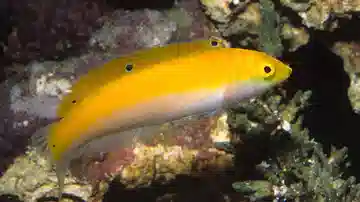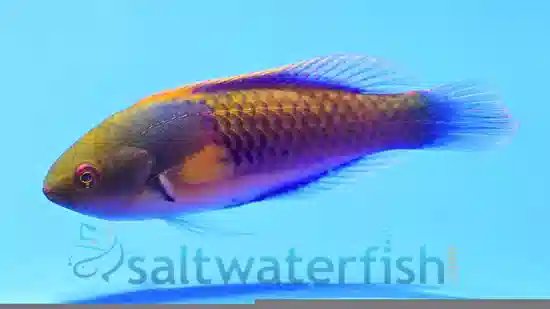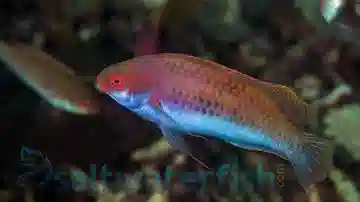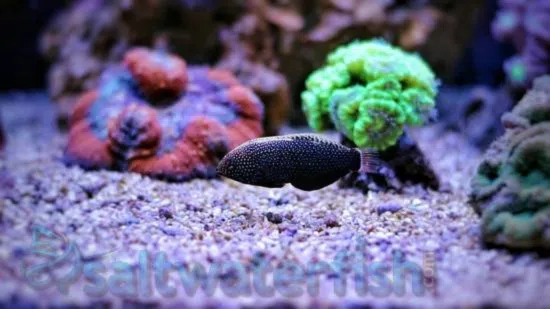Expert Only
Black Leopard Wrasse
Macropharyngodon negrosensis
(1 Reviews)

Expert Only
Black Leopard Wrasse
Macropharyngodon negrosensis
(1 Reviews)
{{ item.name }}
Size: {{ item.extra_field_3 }}
${{ getFormattedPrice(item.saleprice) }} ${{ getFormattedPrice(item.price) }}
To join the waiting list, click here
Free Shipping
With
$199.00
or more in Marine Life.
More details...
Black Leopard Wrasse Care Facts
| Care Level: | Expert |
|---|---|
| Temperament: | Peaceful |
| Diet: | Carnivore |
| Reef Safe: | Yes |
| Minimum Tank Size: | 50 Gallons |
| Max Size: | 5 inches |
The Black Leopard Wrasse is commonly referred as Yellowspotted Wrasse or Leopard Wrasse. It features a dark body with light blue to yellowish spots, which makes it a captivating specimen in your tank. The Black Leopard Wrasse requires a tank of 50 gallons with plenty of rocks to give an opportunity to carry out its natural browsing behavior in captivity. Its diet should include vitamin enriched frozen mysis shrimp, vitamin enriched frozen brine shrimp, and other meaty foods along with high quality marine flake and marine pellet food.
Due to its specialized eating habits and nature, the Black Leopard Wrasse should only be attempted by intermediate to advanced aquarists, since it is difficult to handle. The tank requires a thick sand bed, where the Black Leopard Wrasse can sleep and take rest. The Black Leopard Wrasse needs to have lot of rocks to ensure an easy transition to captive life, along with a 2 - 4 inch thick sand bed. If it is housed with semi-aggressive fish, the Black Leopard Wrasse might jump out of the tank and therefore we recommend you to put it in a closed lid tank.
Black Leopard Wrasse (Macropharyngodon negrosensis): A Comprehensive Guide for Saltwater Marine Aquariums
The Black Leopard Wrasse (Macropharyngodon negrosensis) is a captivating species that can be a prized addition to your saltwater marine aquarium. This factual guide provides essential information on the Black Leopard Wrasse's care, characteristics, and compatibility within your aquarium setup.
Habitat for the Black Leopard Wrasse
The Black Leopard Wrasse is native to the Indo-Pacific region and commonly found in coral-rich areas, sandy substrates, and shallow reef environments.
Are Black Leopard Wrasse Reef Safe?
Black Leopard Wrasses are generally considered reef-safe. They display minimal interest in harming corals or invertebrates. However, they may eat small crustaceans like copepods and amphipods.
Size of the Black Leopard Wrasse
These wrasses are relatively small, growing to an average length of approximately 4 to 5 inches.
How Long Does the Black Leopard Wrasse Live?
Under proper care, Black Leopard Wrasses can live for 2 to 5 years, providing an engaging and dynamic presence in your marine aquarium.
The Black Leopard Wrasse's Diet in Captivity
Black Leopard Wrasses are carnivorous and require a specialized diet. Offer them a diet rich in live copepods, amphipods, and other small crustaceans. Additionally, they may accept finely chopped or live frozen foods like mysis shrimp and brine shrimp. For this reason, they are considered “expert Level” for their care.
Aquaculture Availability of the Black Leopard Wrasse
Aquacultured Black Leopard Wrasses are not available to hobbyists. They are typically sourced from the wild. Choose a responsible supplier.
Sexual Dimorphism of the Black Leopard Wrasse
Black Leopard Wrasses exhibit sexual dimorphism. Males typically have more vibrant colors and patterns compared to females.
Symbiotic Relationships of the Black Leopard Wrasse
Black Leopard Wrasses do not typically form symbiotic relationships with anemones or corals. They are solitary and prefer to forage among the sand and rocks.
Compatibility of the Black Leopard Wrasse With Other Tank Mates
Black Leopard Wrasses are known for their peaceful temperament and can coexist with various tank mates, especially those who share their peaceful nature.
Temperament of the Black Leopard Wrasse
These wrasses are known for their gentle disposition and add movement and vibrancy to the aquarium as they swim and explore their environment.
Suitable Tank Mates of the Black Leopard Wrasse
- Firefish Goby (Nemateleotris magnifica): A non-aggressive species that adds movement and visual interest.
- Chalk Bass (Serranus tortugarum): Peaceful and visually appealing, offering diversity to your tank.
- Royal Gramma (Gramma loreto): A striking and peaceful fish occupying a different tank niche.
- Six-Line Wrasse (Pseudocheilinus hexataenia): A small, active wrasse complements the Black Leopard Wrasse's temperament.
- Tailspot Blenny (Ecsenius stigmatura): A small, peaceful blenny that adds to the dynamic of the tank.
Tank Requirements for the Black Leopard Wrasse
- Minimum Aquarium Size: A tank with a capacity of 50 gallons or more is suitable for housing Black Leopard Wrasses.
- Aquascaping: Provide a sandy substrate for them to sift through and live rock structures with hiding spots. A mature tank with ample copepod populations is beneficial.
Water Conditions for the Black Leopard Wrasse
- pH: Maintain the pH level between 8.1 and 8.4.
- Salinity: Keep the salinity within the range of 1.023 to 1.025.
- Water Temperature: The recommended temperature range is 75°F to 82°F (24°C to 28°C).
- Water Flow: A moderate water flow is suitable to mimic their natural environment.
Other Common Names for the Black Leopard Wrasse
The Black Leopard Wrasse may also be known as the Leopard Wrasse or the Polka Dot Wrasse.
Why Choose Black Leopard Wrasses from Saltwaterfish.com
Selecting Black Leopard Wrasses from Saltwaterfish.com offers marine enthusiasts the opportunity to introduce a visually captivating and peaceful species to their saltwater marine aquarium. Our commitment to providing healthy and well-acclimated specimens ensures you receive robust and vibrant fish for your aquatic environment. With our extensive experience and dedication to marine life, Saltwaterfish.com is a dependable source for enthusiasts seeking quality marine species.
The Black Leopard Wrasse's striking appearance and gentle temperament make it an excellent addition to your saltwater marine aquarium. By adhering to their specific care requirements and providing an environment that suits their needs, you can enjoy the dynamic presence this captivating marine inhabitant brings to your tank.
Expert Only: Items designated as expert only require special care such as a species specific environment, special diet or care, and an expert level, experienced aquarist. Not for beginners. Expert Only items qualify for our live arrival guarantee only, and are exempt from our extended 8 day guarantee.
Reviewed by: Richard Thomas on Sept. 24, 2014















